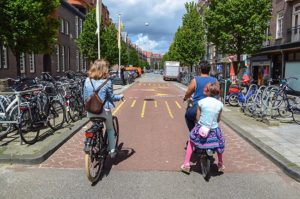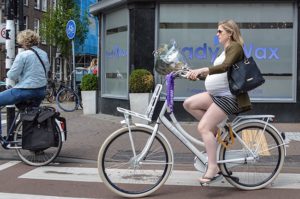 Can the 8-million city of London learn from the middle-sized cities? At the London-based Travel Watch event (November 22), the independent watchdog for transport users, Ruth Oldenziel argued that the cycling culture’s diversity in London’s boroughs are indeed comparable to Dutch cities’ variety in cycling. Building cycling lanes are not the only precondition for attracting cycling. The event and the Twitter feed drew planners, politicians, public-transit defenders, and cycling activists.
Can the 8-million city of London learn from the middle-sized cities? At the London-based Travel Watch event (November 22), the independent watchdog for transport users, Ruth Oldenziel argued that the cycling culture’s diversity in London’s boroughs are indeed comparable to Dutch cities’ variety in cycling. Building cycling lanes are not the only precondition for attracting cycling. The event and the Twitter feed drew planners, politicians, public-transit defenders, and cycling activists.
Author: Ruth Oldenziel
In the News. Parking Messiness as Gold Standard
 Campus authorities everywhere view parked bicycles as an eyesore. Not so fast. Adri de la Bruhèze argues that is a political issue in his interview with Twente University. If cycling is to be part of sustainable mobility mix, why not embrace the sea of parked bicycles as a much desirable symbol of sustainability?
Campus authorities everywhere view parked bicycles as an eyesore. Not so fast. Adri de la Bruhèze argues that is a political issue in his interview with Twente University. If cycling is to be part of sustainable mobility mix, why not embrace the sea of parked bicycles as a much desirable symbol of sustainability?
In the News. Amsterdammers Push Policy

For about a century Amsterdammers have pushed policy makers to make room for cycling. Chris Bruntlett marvels about Amsterdam cycling utopia and observes its history on the street. The story of Amsterdam is one of Amsterdammers appropriating the streets for cycling in any way imaginable. It also has been a story of traffic calming rather than bike paths to create a streetscape where cyclists rule and motorists are guests. That said, not just motorists pay a price. So do pedestrians.
Book Review. Cyclists Persist

The Dutch national newspaper NRC marvels about how cyclists persisted despite car-governed planners. Social movements matter in how communities develop into true cycling cities or not.
In the News. Eindhoven City of “Bicycle Bling”

Chris and Melissa Bruntlett found cycling in the Philips company town of Eindhoven, alive and well with a lot of “bicycle bling”: spectacular cycling infrastructural innovations. They wondered whether this is the way to go forward and asked historian and author Frank Veraart. He pointed to the 1960s infrastructural experiment of vertical separation with bicycle tunnels and sunken bicycle roundabout. As Veraart and the Cycling Cities explains, in 1961, the city hired German Engineer Karl Schaechterle to draw up a traffic plan to help solve their congestion problems. His plan, in its most basic form, was to separate “slow” traffic from “fast”. Engineers largely realized this idea through constructing tunnels underneath newly built car-only highways.
The high-tech experiments are continued in the much-celebrated Hovenring and Starry Night Bike Path, homage to Vincent Van Gogh – who lived for a number of years in the nearby village of Nuenen – recalls Eindhoven’s innovative past and future. The kilometer-long trail combines solar-powered, glow-in-the-dark stones with LED lighting, creating a visual spectacle. These spectacular projects reinforce Eindhoven’s branding efforts as the high-tech city, but also question whether they help improve cyclists’ experiences.
Book Review. Best Summer Read


Amsterdam Cycling Chic writes. The Best Summer Read: “We were lucky enough to take a ride and have a coffee with esteemed Professor, lecturer, and researcher Ruth Oldenziel, co-author of the latest and greatest book Cycling Cities: The European Experience. It’s 200 pages are carefully researched and thoughtfully describe how cycling came to be (or not so much) in several European cities – with Dutch cities as a backbone story of cycling decline, automobility, then incremental change towards what are now urban cycling “success stories”. Of course every city has its own story, culture, and responses to change, and this work delves into those stories from 14 cities in 9 countries. From Budapest’s bicycling revival to Manchester’s “standstill”; Lyon;s corporate enterprise to innovations in Malmö we can read about diverse trajectories in urban cycling but all with the same goal: to get more people on bikes.” Amsterdam Cycling Chic interviews one of the authors.
In the News. Bikeable City Index

In search of the most conducive conditions for D.C., The Washington Post examines the cultural dimensions of the bikeable city. “The measurement of how successful cycling culture is its inclusivity”, explained Ruth Oldenziel in an interview with the newspaper. Both visionary policymakers and a vibrant social movement are important to make cycling accessible for all.
Academy. Summer School Planning the Cycling City
 How to create a cycling city? And is Amsterdam the real deal as the cycling capital of the world or not? Yesterday, Ruth Oldenziel kicked off the conversation with a guest lecture at the University of Amsterdam’s Summer School Grad Course Planning the City, where thirty scholars and practitioners from all over the world are studying these questions. These students were surprised to learn from Cycling Cities that Amsterdam’s history with cycling is checkered and almost an accident of history. The students learned about the five factors explaining why some cities cycle and others do not.
How to create a cycling city? And is Amsterdam the real deal as the cycling capital of the world or not? Yesterday, Ruth Oldenziel kicked off the conversation with a guest lecture at the University of Amsterdam’s Summer School Grad Course Planning the City, where thirty scholars and practitioners from all over the world are studying these questions. These students were surprised to learn from Cycling Cities that Amsterdam’s history with cycling is checkered and almost an accident of history. The students learned about the five factors explaining why some cities cycle and others do not.
Policy. Dutch Public Works Administration gives Cycling Union Reps their Own Copy
The Dutch Public Works Administration (RWS) gave representatives of over 200 local chapters of the Dutch Cycling Union their copy of Cycling Cities during the Annual Meeting on June 17, 2016.
Book Review. “The Must-Have Book”
 In his book review, history-trained and cycling professional Wim Bot calls Cycling Cities the indispensable book. Anyone interested in cycling policy should have it on their bed stand.
In his book review, history-trained and cycling professional Wim Bot calls Cycling Cities the indispensable book. Anyone interested in cycling policy should have it on their bed stand.